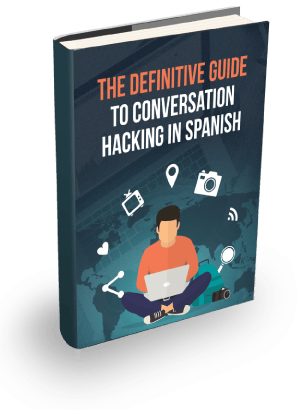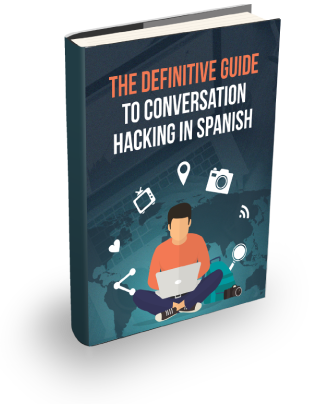 There are almost a limitless number of options to learn Spanish online. Possibilities include apps, one-on-one mentoring, software, free tools, paid tools, hangouts, webinars, YouTube videos etc.
There are almost a limitless number of options to learn Spanish online. Possibilities include apps, one-on-one mentoring, software, free tools, paid tools, hangouts, webinars, YouTube videos etc.
In this post I’m going to cover how you should approach your study online. More importantly I’m going to discuss how knowing when to go offline will help you get to conversational Spanish faster.
For starters, before you decide how you are going to learn online you need to think about the best time to go offline.
When should you go offline? The answer is simple … as soon as you can!
With the knowledge that you should go offline as soon as you can, you need to determine when that time should be and how you are going to get there as quickly as possible.
How To Learn Spanish Online
Now that you know the idea is to go offline as soon as possible, you need to fill your knowledge gap so you can be ready for the move into the real world.
You need to plug the holes in your Spanish skills so that the transition to offline can happen sooner and will be easier.
In an earlier video post I covered the five steps you need to take to go from zero to conversational in Spanish. A quick recap is as follows:
- Learn conversational vocabulary
- Learn conversational grammar
- Improve your listening skills
- Build your second language rapport skills
- Make mistakes
The point where you can transition to the offline world is just after step 3.
Step 1 – Vocabulary
When you first start out in Spanish it is a very difficult to start conversing with someone when you literally can’t say a thing. Your first few words maybe ‘hola’ and ‘¿cómo estás?’, these words are a great start but would leave you in a tricky place if you tried to converse with someone who knows zero English.
You want to build to a point where your vocabulary is good enough to be able to grow your vocabulary without referring back to English. What do I mean?
Remember the game Taboo? The idea is that you have to describe something without saying it. For example, describe the word ‘food’ without using ‘meal’, ’eating’, ’dinner’, ’breakfast’, ’lunch’.
If your vocabulary is good enough to play this game and you can describe something in more than one way then you are ready to move on to step 2.
Step 2 – Grammar
Conversational grammar is not too difficult – you can get to a good enough level relatively quickly.
You need to focus on forming sentences, basic verb conjugations and getting an idea of the tenses (past, present and future).
Don’t worry about subjunctive and don’t worry about knowing the grammar perfectly.
Check out The Guide to Spanish Grammar Hacking.
A few other resources that I recommend are:
http://en.wikipedia.org/wiki/Spanish_grammar (Wikipedia’s Spanish grammar quick reference guide is handy)
http://www.123teachme.com/spanish_verb_conjugation (Spanish verb tables – choose a few and print them off for reference)
Get familiar with the regular verb tables and a few of the high frequency irregular verbs and that’s it. You are ready for step 3.
Step 3 – Listening Comprehension
This is one of the tougher skills to acquire, but again focus on getting to a point where you can transition to offline as soon as possible.
There are again lots of courses out there that focus on improving your listening comprehension but you need to find one that has active listening exercises.
Active listening is critical for building listening comprehension and you may struggle to get there with passive listening alone.
Once you have built your skills in steps 1, 2 and 3 you are ready to go offline and which you should do right away.
If you want help with your online Spanish learning, check out the Real Fast Spanish School. The school is designed to help you with this first phase of learning—what words to learn and in what order. There is also mindset, active listening training and podcast transcripts.
How To Make The Leap Offline
When I say go ‘offline’, what I mean is speaking with a real person in the real world.
You could use online tools such as Skype to have a conversation but at this stage you aren’t using software learning tools or apps.
The best offline option is to go to a Spanish speaking country. When you get there, try to avoid hanging out with expats. Put yourself in a situation where you have to speak locals.
Go to markets away from the main tourist areas. Attend community events and go to festivals. Look for where the locals go and get involved.
The next best option is to find a conversation partner in your local area. Maybe you already know someone who speaks Spanish. You could approach them for a language swap – if they are learning English. They may be sufficient in English already and just happy to help out.
If you feel really bad about taking up their time you can offer to pay them. This has an additional benefit—if you are paying them there will be more focus on you and your Spanish in order to make the time worthwhile.
Another option is to use a language exchange website to find a language swap partner. A few of my favorites are:
http://www.language-exchanges.org/
http://www.conversationexchange.com/
I have used all three and made life long friends out of the process. I highly recommended using a language exchange website when you are ready.
Summary
The first step is to get your Spanish to a point that you are ready to go offline using online tools and courses.
Then when are you ready, get out into the real world. Start to use your new skills, make mistakes and have real learning adventures.
From personal experience, the part where you get out into the real world is where learning Spanish is most the satisfying and fun. Not only is it more enjoyable but you really start to experience the benefits of choosing the path to a speaking a second language.



Leave a Reply